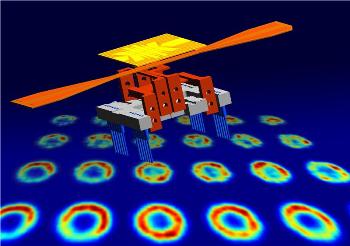Mar 1 2013
Order tends towards disorder. This is also true for quantum states. Measurements at the Vienna University of Technology show that in quantum mechanics this transition can be quite different from what we experience in our daily lives.
 The Atom chip (above) - in the background the measured distributions are shown, whicht characterize the quantum physical state of the condensate.
The Atom chip (above) - in the background the measured distributions are shown, whicht characterize the quantum physical state of the condensate.
Ice cubes in a cocktail glass melt until an equilibrium state is reached in which the ice cubes are gone. After that, the geometric shape of the ice cubes is completely lost. The liquid does not contain any memory of their shape, the ordered ice crystal has turned into disordered water molecules. Ultra cold Bose-Einstein condensates behave differently; these highly ordered clouds of ultra cold particles also approach a disordered equilibrium state, but they retain some “memory” about their initial state for a remarkably long time. This phenomenon does not depend on the temperature, it seems to be a stable, fundamental property of quantum physics.
Stopover on the Way to Chaos
In 2012, the research group around Professor Jörg Schmiedmayer at the Vienna Center for Quantum Science and Technology (VCQ), Vienna University of Technology, were able to show that they have found an intermediate state between order and disorder; the atoms of an ultra cold Bose-Einstein condensate tend towards an equilibrium state, in which their quantum physical properties are not visible any more.
This, however, does not happen continuously like the transition from an ice cube to liquid water. Instead, there is an intermediate step called “prethermalized state”, in which the atoms remain for a surprisingly long time without forgetting about their quantum mechanical origin. “If we split the atom cloud into two parts and recombine them after some time, a wave pattern forms”, Jörg Schmiedmayer explains. “That is proof that the atom clouds still contain information about having emerged from a highly ordered quantum physical state.”
Intermediate State Independent of Temperature
Now the scientists have managed to take a closer look at this transition – and it turns out to be remarkably stable with respect to external conditions. From experience, we are used to the opposite case: “Imagine a room full of air, and a vacuum in the room next to it”, says Max Kuhnert (Vienna University of Technology). “When we open a door between those rooms, the system approaches an equilibrium, until the molecules are evenly distributed in the two rooms. This transition, however, strongly depends on external parameters such as pressure and temperature.” The higher the pressure and the temperature, the faster information about the initial state is lost – be it information about the initial distribution of air molecules or about the geometry of melting ice cubes.
“The prethermalized state of our atom clouds is reached quite independently from pressure and temperature”, says Max Kuhnert. The experiments, which have now been published in Physical Review Letters, show that this state is characterized by a new length scale. This so-called correlation length is a direct measure of the quantum memory of the ordered initial state. It is the length scale on which the quantum physical properties of the atom clouds can still be perceived.
“This emergent correlation length is defined by the density of the initial quantum gas, but it only becomes visible in the dynamics of the transition from an ordered state into the prethermalized state” says Jörg Schmiedmayer. “The fact that this correlation length does not depend on the initial temperature at all strongly indicates that the prethermalized state is a fundamental property of quantum physics and has major significance”, Max Kuhnert believes.
A deeper understanding of this quantum state is expected not only to explain ultra cold Bose-Einstein condensates, it may also shed some light on the processes in the early universe, or it could help to understand phenomena in the quark-gluon-plasma created in high energy particle accelerators.